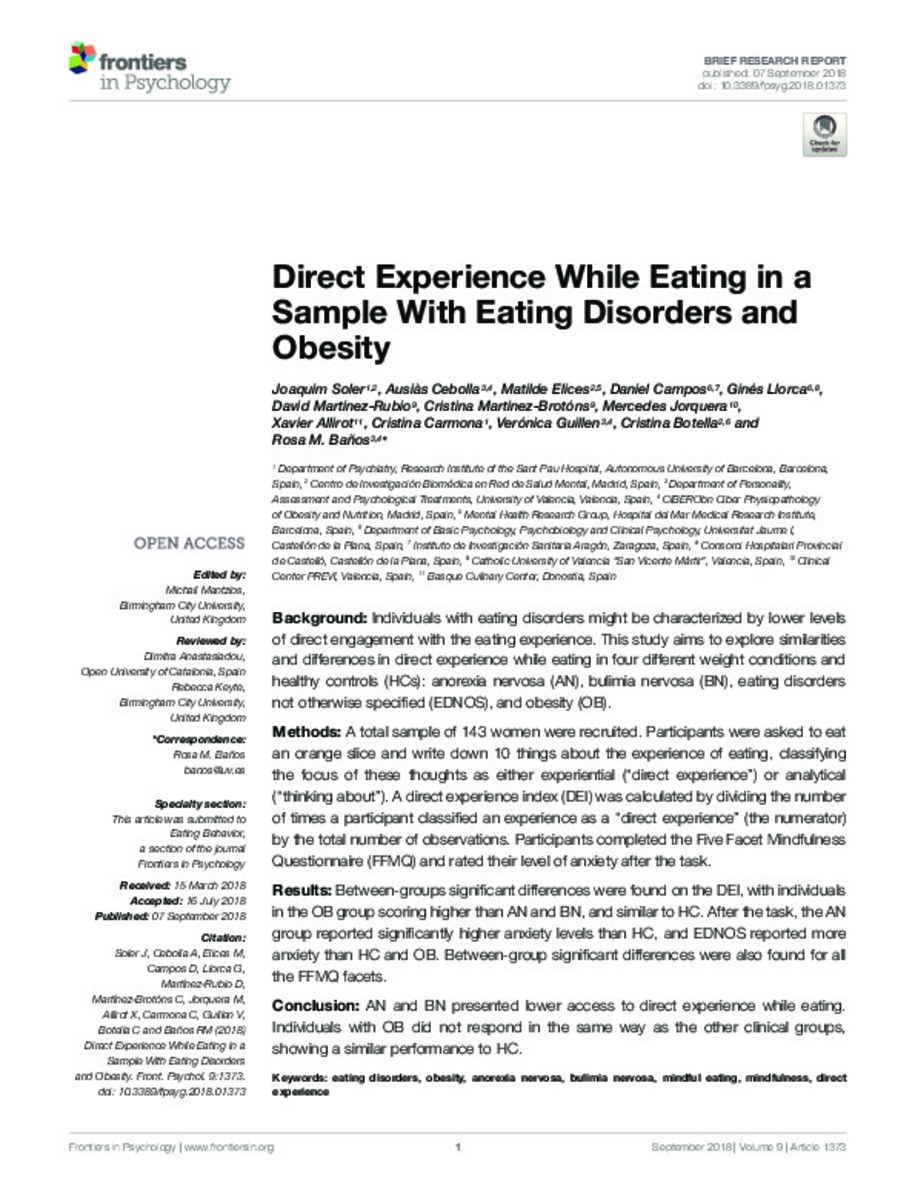Mostrar el registro sencillo del ítem
Direct Experience While Eating in a Sample With Eating Disorders and Obesity
| dc.contributor.author | Soler, Joaquim | |
| dc.contributor.author | Cebolla Marti, Ausias | |
| dc.contributor.author | Elices, Matilde | |
| dc.contributor.author | Campos, Daniel | |
| dc.contributor.author | Llorca, Ginés | |
| dc.contributor.author | Martínez-Rubio, David | |
| dc.contributor.author | Martínez-Brotons, Cristina | |
| dc.contributor.author | Jorquera Rodero, Mercedes | |
| dc.contributor.author | Allirot, Xavier | |
| dc.contributor.author | Carmona, Cristina | |
| dc.contributor.author | Guillen, Veronica | |
| dc.contributor.author | Botella, Cristina | |
| dc.contributor.author | Baños, Rosa Maria | |
| dc.date.accessioned | 2018-11-13T08:59:53Z | |
| dc.date.available | 2018-11-13T08:59:53Z | |
| dc.date.issued | 2018-09-07 | |
| dc.identifier.citation | SOLER, Joaquim; CEBOLLA I MARTÍ, Ausiàs Josep; ELICES, Matilde; CAMPOS, Daniel; LLORCA, Ginés; MARTÍNEZ-RUBIO, David; MARTÍNEZ-BROTONS, Cristina; JORQUERA RODERO, Mercedes; ALLIROT, Xavier; CARMONA, Cristina; GULLÉN BOTELLA, Verónica; BOTELLA, Cristina; BAÑOS RIVERA, Rosa María (2018). Direct Experience While Eating in a Sample With Eating Disorders and Obesity. Frontiers in Psychology, v. 9 | ca_CA |
| dc.identifier.uri | http://hdl.handle.net/10234/177419 | |
| dc.description.abstract | Background: Individuals with eating disorders might be characterized by lower levels of direct engagement with the eating experience. This study aims to explore similarities and differences in direct experience while eating in four different weight conditions and healthy controls (HCs): anorexia nervosa (AN), bulimia nervosa (BN), eating disorders not otherwise specified (EDNOS), and obesity (OB). Methods: A total sample of 143 women were recruited. Participants were asked to eat an orange slice and write down 10 things about the experience of eating, classifying the focus of these thoughts as either experiential (“direct experience”) or analytical (“thinking about”). A direct experience index (DEI) was calculated by dividing the number of times a participant classified an experience as a “direct experience” (the numerator) by the total number of observations. Participants completed the Five Facet Mindfulness Questionnaire (FFMQ) and rated their level of anxiety after the task. Results: Between-groups significant differences were found on the DEI, with individuals in the OB group scoring higher than AN and BN, and similar to HC. After the task, the AN group reported significantly higher anxiety levels than HC, and EDNOS reported more anxiety than HC and OB. Between-group significant differences were also found for all the FFMQ facets. Conclusion: AN and BN presented lower access to direct experience while eating. Individuals with OB did not respond in the same way as the other clinical groups, showing a similar performance to HC | ca_CA |
| dc.format.extent | 6 p. | ca_CA |
| dc.format.mimetype | application/pdf | ca_CA |
| dc.language.iso | eng | ca_CA |
| dc.publisher | Frontiers Media | ca_CA |
| dc.relation.isPartOf | Frontiers in Psychology (2018), v. 9 | ca_CA |
| dc.rights | Atribución 4.0 Internacional | * |
| dc.rights.uri | http://creativecommons.org/licenses/by-sa/4.0/ | * |
| dc.subject | Eating disorders | ca_CA |
| dc.subject | Obesity | ca_CA |
| dc.subject | Anorexia nervosa | ca_CA |
| dc.subject | Bulimia nervosa | ca_CA |
| dc.subject | Mindful eating | ca_CA |
| dc.subject | Mindfulness | ca_CA |
| dc.subject | Direct experience | ca_CA |
| dc.title | Direct Experience While Eating in a Sample With Eating Disorders and Obesity | ca_CA |
| dc.type | info:eu-repo/semantics/article | ca_CA |
| dc.identifier.doi | https://doi.org/10.3389/fpsyg.2018.01373 | |
| dc.rights.accessRights | info:eu-repo/semantics/openAccess | ca_CA |
| dc.relation.publisherVersion | https://www.frontiersin.org/articles/10.3389/fpsyg.2018.01373/full | ca_CA |
| dc.type.version | info:eu-repo/semantics/publishedVersion | ca_CA |
Ficheros en el ítem
Este ítem aparece en la(s) siguiente(s) colección(ones)
-
PSB_Articles [1310]
Articles de publicacions periòdiques








